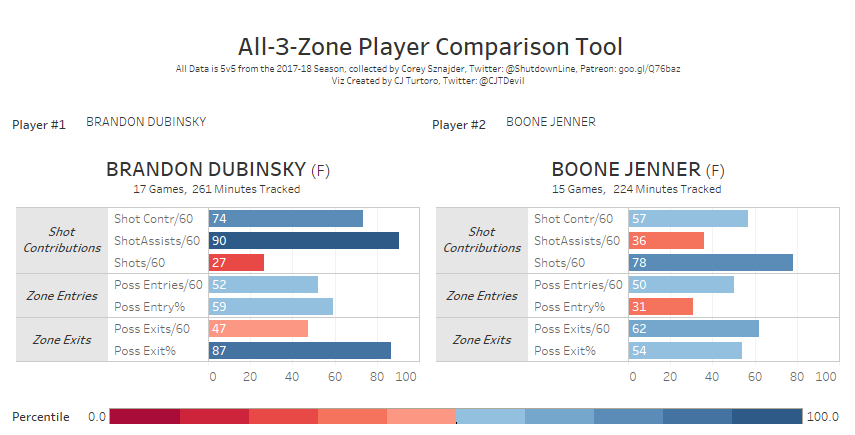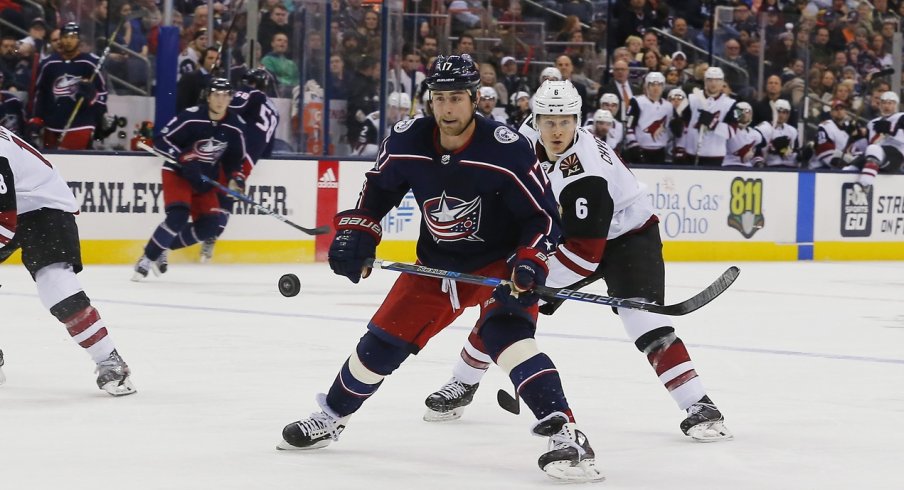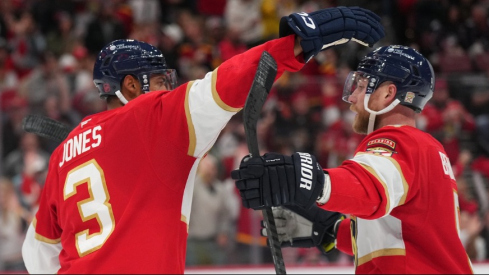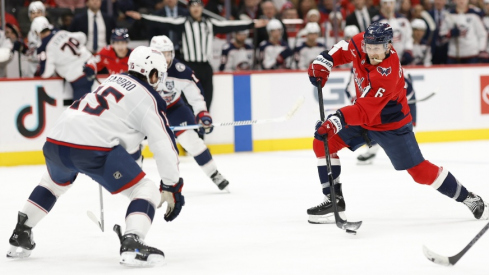The Blue Jackets will have Brandon Dubinsky back in the lineup tonight when they take on the Minnesota Wild.
Dubinsky has been out since Dec. 12 with an eye injury, and his absence really seems like the precursor to the Jackets' issues over the last two months.
In the 31 games prior to Dubinsky’s injury the Jackets were one of the stronger teams in the NHL. They had a 19-11-1 record, good for 39 points and eighth place in the overall standings. Their underlying stats supported the strong play, as they had the NHL's sixth-best Corsi at 5-on-5 (52.72%) per Natural Stat Trick.
Since Dubinsky’s injury the team has played to an 8-8-2 record (18 points), tied for 20th in the league over that span. Not surprisingly their stats have fallen as well; the team's Corsi over that 18-game period has been 47.93%, 24th in the league.
Dubinsky’s stats this season have been well below average. He has just three goals and 12 points, tied for 13th on the team with Boone Jenner. His advanced stats aren’t much better, with a career-worst 47.54% Corsi at 5-on-5, which ranks 14th on the team.
His stats are poor, but don’t let that fool you: Dubinsky is a significant piece of this team and getting him back is a big boost.
In fairness to Dubinsky, John Tortorella isn't doing him any favors; he's using Dubinsky in seemingly every defensive situation. Dubinsky and his usual line mates, Jenner and Cam Atkinson, rarely started their shifts in the offensive zone. Among lines that have played 50 minutes together at 5-on-5, the Dubinsky-Atkinson-Jenner line has the 17th-lowest zone start percentage in the league, starting just 33.65% of their shifts in the offensive zone, per Corsica.
Zone starts are not the be-all-end-all, as the majority of shifts start on the fly, but looking at how Dubinsky is used in other situations, he averages a forwards-leading 1:48 on the penalty kill. It’s clear that Dubinsky is being used as a shutdown player.
With Dubinsky out of the lineup, someone else had to fill that role and Tortorella thrust it upon Jenner. In the games Dubinsky missed, Jenner had the second-lowest offensive zone start percentage trailing only Sonny Milano, and he was not able to handle that role in the absence of Dubinsky: Jenner’s 5-on-5 Corsi in the games Dubinsky missed was 43.96%, seventh-lowest on the team among players who played in at least five games.
This is one of the reasons why the Blue Jackets are struggling. Their defensive group was routinely stuck in its own end and couldn’t alleviate the pressure, putting added stress on the rest of the team to pick up the slack.
Nick Foligno and Oliver Bjorkstrand were two players who felt that extra burden. Their defensive roles were increased and, in turn, their offensive production suffered. The goal of a shutdown line is to get the puck out of the zone, transitioning the puck up the ice and either creating an offensive opportunity for yourself and if not, at least getting the puck into a better position for your more offensively-inclined teammates.
Dubinsky does a very good job at that, which is why he's best suited in that role. This upcoming visual really displays how well Dubinsky moves the puck, and how that compares to Jenner.
This chart is from CJ Turtoro (@CJTDevil); he took the zone entry and zone exit data tracked by Corey Sznajder and turned it into a really solid comparison tool.

The numbers here don’t matter too much, as the legend at the bottom indicates these are percentiles as opposed to actual values.
What this does show is the shot contributions and transitional stats between the two players. In the top section we see that Dubinsky’s shot contribution numbers are much better, as Dubinsky has been excellent at passing the puck this season. He rates in the 90th percentile in shot assists (any pass that leads to a shot or shot attempts is considered a shot assist) per 60 minutes. He averages 12.17 primary shot assists per 60, the third highest mark on the team behind Artemi Panarin and Pierre-Luc Dubois.
The main takeaway from this should be the bottom two sections – zone entries and exits. The two players are comparable in possession entries per 60, with Jenner having an edge in possession exits per 60. Dubinsky, though, does a much better job at keeping possession of the puck, he gets the puck out of the zone with possession (poss. exit%) and into the zone (poss. entry%) with control at a much higher rate.
Dubinsky is able to get the puck out of the defensive zone, and can then either create an opportunity for himself, set up someone like Cam Atkinson for a chance, hold the puck and Tortorella can send out players like a Foligno or Bjorkstrand, or Dubinsky can put the puck on net and force a whistle, allowing Tortorella to start the big PB&J line in the offensive zone.
Admittedly this isn’t a very big sample, but it jives with what we've seen in the past and what we’ve seen this season from these two players.
Getting Dubinsky back is going to be a big help for the Blue Jackets. Not only does he bring that physicality and “warrior mentality,” but he’s been a very strong defensive player.
Tortorella buries him in the defensive zone, giving the coach the flexibility to shelter some of other players with favorable deployment. In Dubinsky’s absence, the team could not fill that role and their play suffered. His return should help get this team get back on track and just in time, as they gear up for what is going to be one tough month of February.
Follow 1st Ohio BatteryFacebook, Twitter, Instagram and YouTube


